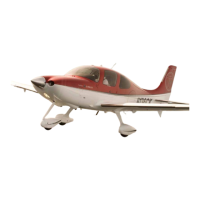3-18 P/N 13772-003
Section 3 Cirrus Design
Emergency Procedures SR22T
Engine System Emergencies
Engine Partial Power Loss
1. Air Conditioner (if installed)......................................................OFF
2. Fuel Pump....................................................HIGH BOOST/PRIME
3. Fuel Selector........................................................ SWITCH TANKS
4. Mixture ............................. CHECK appropriate for flight conditions
5. Power Lever ....................................................................... SWEEP
6. Ignition Switch ...................................................... BOTH, L, then R
7. Land as soon as practical.
Amplification
• WARNING •
If there is a strong smell of fuel in the cockpit, divert to the
nearest suitable landing field. Fly a forced landing pattern and
shut down the engine fuel supply once a safe landing is
assured.
Indications of a partial power loss include fluctuating RPM, reduced or
fluctuating manifold pressure, low oil pressure, high oil temperature,
and a rough-sounding or rough-running engine. Mild engine
roughness in flight may be caused by one or more spark plugs
becoming fouled. A sudden engine roughness or misfiring is usually
evidence of a magneto malfunction.
If for any reason the aircraft experiences an unexpected loss of normal
manifold pressure perform Unexpected Loss Of Manifold Pressure
checklist
Low oil pressure may be indicative of an imminent engine failure. See
Oil Pressure Out of Range - OIL PRESS Warning in this section for
special procedures with low oil pressure.
A damaged (out-of-balance) propeller may cause extremely rough
operation. If an out-of-balance propeller is suspected, immediately
shut down engine and perform Forced Landing checklist.
If the power loss is due to a fuel leak in the injector system, fuel
sprayed over the engine may be cooled by the slipstream airflow which
may prevent a fire at altitude. However, as the Power Lever is reduced
during descent and approach to landing the cooling air may not be
sufficient to prevent an engine fire.
Revision 1

